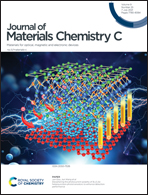Synergistic UV and humidity response of flexible MoS2/Kapton heterointerfaces via photogenerated charge transfer†
Abstract
Realization of high-performance optoelectronic and gaseous sensing with excellent mechanical flexibility may open up broad multifunctional applications, such as wearable smart sensor systems, robust environmental/infrastructure monitoring, and personal health monitoring with human-friendly interfaces. Here, we proposed a flexible MoS2/Kapton sensor with synergistic optical UV and humidity functionalities. Because of its ultrathin monolayer, the electrical transport of the 2D MoS2 channel tends to be affected by both the surface and interface states. The photogenerated charge transfer plays a synergistic role in both the UV and humidity sensing by utilizing band alignment engineering. On the one hand, the photoabsorbing Kapton substrate forms a photogating heterointerface with the 2D MoS2 monolayer to greatly strengthen the photogenerated charge transfer. Under 325 nm UV photoexcitation, the flexible MoS2/Kapton sensor has achieved a best photocurrent to dark current ratio of 3.87 × 105. On the other hand, the 2D MoS2 monolayer has a large surface area for the effective adsorption of water molecules. The UV photogenerated charge transfer is beneficial to boost up the relative humidity (RH) response range above 105 for humidity sensing. As a result, flexible MoS2/Kapton heterointerfaces enable high-performance multifunctional sensing for promising 2D/3D heterogeneous integration.



 Please wait while we load your content...
Please wait while we load your content...